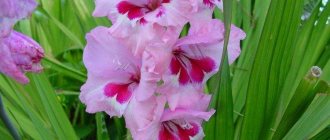Luxurious gladioli in the flower beds of summer cottages always play a leading role. The long skewer immediately catches the eye with its long, sharp leaves, and is especially beautiful during flowering. Undoubtedly, it will decorate any landscape. The difficulty of using gladioli in garden design lies in the selection of neighboring crops that would complement and highlight the beauty of the buds.
Many gardeners like flower beds where gladioli occupy a central place.
Using plants in landscape design
Due to its characteristics, gladiolus is used only for group planting. Plants require support and specific care. The bulbs must be dug up every year, so proximity to perennial flowers is excluded. The culture is combined with flowering annuals. There are plenty of examples of the use of gladioli in landscape design, photos confirm this. When planting plants, select the appropriate retinue, which complements the skewer and serves as a background for the royal flower.
He earned the love of flower growers thanks to his presentable appearance.
Gladularium forms a flower as a monoculture. By combining color combinations of swords, landscape designers and gardeners achieve colorful compositions. Plants are used in mixborders. Plantings are done in the background; in the foreground, the crop will overshadow the others.
Gladioli in the flowerbed always play a dominant role.
When creating a background for primroses and summer flowers, consider:
- the height of the fennel stem, some large-flowered varieties grow over 2 meters;
- short duration of budding, flowers bloom gradually, at the same time the upper buds of the ear develop;
- late blooming, it is an autumn flower.
But when they bloom, gladioli are the leaders in the mixborder composition, attracting everyone’s attention, causing admiration.
In order for the composition to look harmonious, the royal flower requires a retinue, in which it is recommended to use less expressive specimens.
When designing landscapes, other vegetation is combined with fennel. Decorative low and medium-sized shrubs serve as decoration, coniferous crops serve as a compositional addition. The emphasis is on gladiolus plantings. With this approach, the design will be harmonious. A combination with less expressive colors of the same shade or a contrasting color that serves as a frame is allowed.
The entire diversity of gladioli is represented by more than 200 plant species, which in turn number over 1000 varieties.
For reference. Gladiolus is named because of the similarity of its sharp leaves to the legionnaires' weapon - the gladius. Later, the bulbs were believed to bring good luck in battle to Roman soldiers. Thanks to the myth, the flower became popular beyond the borders of the empire.
If you use single specimens in landscape design, gladiolus will lose its majesty.
Planting tulips, how and when to plant bulbs
Autumn is the time when it's time to think about spring.
Time to plant tulips. The best time for planting tulips is when the soil temperature drops to +7-10°C. This usually happens at the end of September - beginning of October. If necessary, a later planting in November is possible, but with subsequent good cover with spruce branches or foliage.
It must be remembered that when planted early, the bulbs take root slowly; high temperatures favor the development of diseases such as fusarium. And for bulbs planted too late, the roots do not always have time to develop before the onset of frost.
Places and soil for planting tulip bulbs. For planting tulips, choose sunny areas protected from the wind. Tulips grow well in any cultivated garden soil, but for the successful cultivation of these flowers, the best is permeable, loose, humus-containing loamy or sandy loam soil. Heavy clay soils can be improved by adding organic matter, such as peat, compost.
The main requirement when planting tulips is good drainage!
Tulips prefer neutral or slightly alkaline soils with a pH of 7.0-7.5. Acidic soils are not suitable for planting tulips and require liming. Before planting, carefully dig up the soil
To remove perennial weeds, the area can be treated with Roundup before digging. The tulip begins to absorb nutrients from the soil around the beginning of March, by which time all nutrients should be available to the plant, i.e. already in the root zone. Organic fertilizers
Applying fresh manure to plant tulips is unacceptable!
Applying fertilizers when planting tulips. Tulips respond very actively to the addition of mineral nutrients. It is better to use a special complex fertilizer for bulbs that has become commercially available, which contains all the necessary nutrients and microelements.
If you cannot purchase it, then you need to apply the following fertilizers when digging the soil: well-rotted humus (up to 5 kg/sq.m.), superphosphate (50-100 g/sq.m.), nitroammophosphate (40-60 g/sq.m. m), granulated bird droppings (200 g/sq.m), ash (200 g/sq.m),
Before planting, you should carefully inspect the bulbs, removing all diseased and rotten ones during storage. Before planting the bulbs, etch with a 0.5% solution of potassium permanganate, treatment time - from 30
Planting is carried out immediately after dressing, since the bulbs quickly absorb moisture,
The planting depth for extra-class tulip bulbs is 15-18 cm. Tulip bulbs of the II and III varieties are planted to a depth of 12 cm, and baby ones - even shallower. On light soils, the bulbs are planted deeper, on heavy soils
If the soil is dry, the furrows are well watered (with KMpO4 possible). To the bottom of the furrow (if there was no
Do not press the bulbs too hard into the soil, as this can damage the swollen roots.
The bulbs are dusted with ash and sprinkled with sand on all sides. Next, the spread out bulbs are covered with soil. If you want to plant tulips not on beds, but to lay out some kind of pattern with them, then the top layer of soil is removed from the entire area of the site.
The bulbs are laid out in a certain order (according to the drawing) on a leveled surface, then covered with previously removed soil.
Tulips are returned to their original place no earlier than after 4 years. With the onset of stable frosts, the plantings can be mulched with peat with a layer of 3-5 cm, which will prevent cracking of the soil in winter, provide an even temperature at the depth of the bulbs and thereby prevent damage to the root system, in addition, maintain looseness of the soil and reduce weed clogging. Peat is not removed in spring.
Valeria Irshenkova
Return to
Return to section- Floriculture
bestgardener.ru
- Country garden design
- Coniferous garden design
- Garden design with paths
- Dacha garden design
- Garden design with petunias
- Cottage design photo
- DIY garden plot design
- Garden design
- Cottage design
- Interesting cottage design
- Decorative garden design
- DIY landscape design photo
- Weaving garden design
- DIY garden design
- Garden design with conifers
- Garden path design
Combination of gladiolus with interior items and other plants
Gladioli are usually planted in a flower bed, in rockeries, and mixborders. Low-growing species are also good in containers and flowerpots, used as potted crops in winter gardens and summer compositions.
Planting a large group of royal flowers can cause some chaos in the flowerbed, which will lose its expressiveness.
Skewer in a flowerpot:
- decorate the flight of stairs;
- will mask a façade defect;
- will become the accent of the flower garden;
- will perform the function of a tapeworm on the ground lawn.
Proper observance of proportions between gladioli and other surrounding vegetation will help to obtain a harmonious composition in landscape design.
Planting in containers is practiced in dachas and open terraces to divide the recreation area into a solarium and a barbecue area. Gladioli often decorate the blind areas of cafes and restaurants and add lush greenery to the city landscape. The root part is decorated with:
- expanded clay;
- small pebbles;
- colored gravel of decorative rocks;
- shells;
- multi-colored shell;
- coconut fiber.
There are many options for combining a flower when it will look beneficial in the overall landscape design picture.
In constantly flowering mixborders, the skewer is placed behind the spring flower crops:
- tender crocuses;
- variegated low-growing primroses;
- a variety of daffodils;
- tulips;
- bearded irises.
Gladiolus received its second name “sword knife” due to its unusual shape, which vaguely resembles a sharp sword.
When the bulbous crops grow, the gladiolus only gains strength and sends out an arrow. Later, the center of the composition becomes perennials planted in the foreground: peonies, daylilies, beardless irises of various colors, low summer phlox. At this time, the sword forms a dense green wall, a perspective background, a background.
The flowers belong to the iris family and are a perennial corm plant.
In autumn, the flower will harmoniously combine only with caps of asters, medium-sized chrysanthemums, and small contrasting dahlias used for border decoration. Bright dahlias and gladioli in mixborders and rockeries are incompatible; the composition will turn out tasteless and tacky. Flowers will compete for primacy in the flowerbed.
Depending on the variety, the period between planting and the formation of buds lasts from 70 to 95 days.
A good complement to gladioli in rock gardens is juniper placed behind the plantings. Neighborhood with ornamental herbal crops is welcome:
- variegated Iberis;
- dark thyme;
- carved Dubrovnik;
- bluish fescue;
- light sandy grate;
- openwork yarrow;
- succulent hostas and heucheras;
- silver beetle (rabbit ears);
- other non-flowering plants.
Snapdragons, small marigolds, ageratums, and lubularia are used as backgrounds. The list goes on. Various combinations of gladioli in the garden are possible; the photo shows the design of plots in different styles. The main thing is that the blooming low-growing flowers match the gladiolus buds in shade, be lighter or darker in the same color scheme, or create a contrast.
The tallest gladioli reach a height of 1.7 m, which is very convenient if you need to create a bright accent in your landscape design.
Note! Combinations of yellow and blue tones always look advantageous; red combines with white, soft blue with purple, lilac, and white.
Secrets of care
Having learned how gladioli are prepared for planting and how the procedure is carried out, we suggest you familiarize yourself with the secrets of care when growing in open ground:
Gladioli should be watered. In hot weather, do the procedure regularly, trying not to hit the arrows. Otherwise, they can be easily damaged. Settled water is used for irrigation. Otherwise, this will lead to the development of tuber diseases.
The crop should be treated regularly with chemicals. Otherwise, the plants will be susceptible to dangerous pathologies. They are also treated against insect pests.
Until the time of flowering, gladioli are fed. They do this with special preparations. Nitrogen fertilizing is also recommended.
Gladioli look beautiful and unique. They will decorate any area or flower bed. The culture is combined with other plants. Tall varieties can be planted in the center of the plot, while low-growing ones look attractive as borders.
Varietal and species diversity
More than 200 species and more than a thousand varietal varieties of fencing are known, with the most incredible colors from white to dark purple. There are plants with monochromatic and variegated buds.
The variety of shapes, sizes and shades provides an innumerable number of options for landscape design using gladioli.
Species and hybrid gladioli are grouped according to various characteristics:
Flowering dates:
- super-early, early ones begin to bloom in the summer, in July, and end in August;
- medium, medium-late produce a peduncle in August;
- late - in September.
Creating a harmonious composition is not an easy task; the main thing here is to ensure that the accent element is commensurate with the accompanying frame.
On average, the duration of flowering is 70 days, in some species up to 95.
The arrangement of flowers on the stem is:
- spicate;
- in a spiral;
- On the one side;
- double-sided
When striving for a rich picture, do not forget about moderation in order to avoid clumsiness.
The buds vary in size:
- small up to 7 cm;
- small-flowered with a diameter of up to 10;
- medium-flowered - up to 12;
- large – up to 15;
- gigantic up to 17 cm.
According to the shape and color of the buds, gladioli are distinguished into 11 varietal groups with smooth, torn, corrugated, contrasting edges, colored, combined cores.
To ensure that the landscape design area with gladioli does not gape empty, you should take care of bright colors for the rest of the period.
Using different types, it is easy to form a multi-level, long-blooming flower garden.
For reference. The largest-flowered gladioli have corrugated petal edges. Up to 30 flowers are formed in a spike.
It is optimal to use different varieties of gladioli in landscape design relative to the flowering period, then the flowerbed will glow with bright colors for at least one month.
Preparing gladioli for winter
Since gladioli are perennials, in theory the bulbs should remain in the ground over the winter. But in Russia the winters are too cold and this option is not suitable anywhere except perhaps the southernmost regions. Therefore, having mastered the technique of planting gladioli, do not forget to master the methods of digging up the bulbs.
For central Russia, the optimal time for removing bulbs from flower beds is the first half of autumn. From September to mid-October, you need to find a moment when the soil is neither too dry nor too wet. Because in both cases it will be difficult to select all the “children”. And if they remain in the ground, then some of them will certainly survive the winter and germinate next year, threatening cross-pollination and degeneration of the varieties.
It is also important to note that cleaning the flower bed should not occur too late, when the earth has cooled down greatly.
The order of harvesting different varieties is determined by the timing of their flowering. The earlier the variety, the earlier its bulbs should be dug up. Also, first of all, preference is given to old bulbs, since they are more susceptible to diseases when left in the ground for a long time.
If you had to dig up the tubers in wet weather and they turned out to be very dirty, you can carefully wash them with water, but then you should definitely dry them. Many gardeners also treat freshly dug bulbs with insecticides and fungicides, but this procedure is not at all necessary.
The stems of dug up plants must be cut off, leaving a stump 1-1.5 cm high. It is advisable to dry the bulbs before storing them for winter. To do this, they are laid out in separate trays (preferably in one layer) and left in a well-ventilated area for two months. For the first two weeks, the room temperature should be 25-30ºС, then - 20-22ºС.
Rules for selecting a place for planting gladioli in the garden
For gladioli in the flowerbed (photo), choose illuminated, dry areas with fertile soil. To grow full-fledged arrows, the bulbs should be planted in a permanent place after frost. Skewer is heat-loving and quite capricious for growing in temperate latitudes. There should be open access to it for gartering, feeding, and loosening. Wilted buds need to be plucked out regularly.
The optimal number of gladioli in one group planting is from 10 to 15 specimens.
Note! The shade of the petals is influenced by a number of factors: light, soil nutrition, age of the bulb. With a lack of minerals, the color fades; when there is little light, the size of the bud decreases.
The right background for gladioli
A suitable background for fencing is uniform green foliage and coniferous plants. It is better to place bushes with beautiful foliage in the foreground. Iberis , thyme , agastache , initial plant , southern baptisia , Dubrovnik , and meadowsweet yarrow are perfect . Cereals always looked spectacular with gladiolus: sesleria , fescue, switchgrass , sand grass .
Chistets (rabbit ears) are a permanent resident of city flowerbeds. It will also be a good background.
Heucheras , hostas , as well as annual marigolds , zinnias , and snapdragons will be an excellent addition to fudge . Tall white or blue ageratums , celosia , silver cineraria . The edging can be made from lobularia .
Important! Don't blame the sellers if you get a flower of a different shade than what you were shown in the picture. The color of the skewer can be affected by the type of soil, the age of the bulbs and the level of light.
Simple tips for creating mixed flower beds with gladioli
The use of low-growing gladioli in landscape design is justified on paths, ridges, lawns, and lawns in border planting. Low-growing varieties of fennel are used in the border design of paths and lawns. Neighboring flowers of large species should be lower in height so as not to overshadow the beauty of gladioli.
In the background of a flower bed with gladioli, it is recommended to use plants that are uniform in structure and color.
You should not create too large a monoflower from fennel, it will look like a plantation of flowers intended for bouquet cutting. To fix tall stems, thin, inconspicuous or spectacularly designed supports are selected, and trellis structures are used.
Depending on the height of the skewer, in most cases during the flowering period they need to be equipped with supports that will support heavy inflorescences.
The beauty of the flower is self-sufficient, but if planted alone, it will get lost. The optimal number of bulbs in a group to obtain an expressive color spot is from 10 to 15.
Photos of gladioli in landscape design confirm the sophistication of royal beauty flowers.
Important! When forming compositions, planting material is selected that matches the color and size of the flowers. Combined (variegated) ones are planted separately from plain ones, small ones from large ones.
Pre-planting preparation of tubers
The preparation of planting material should begin 2-3 weeks before the scheduled planting time. Available tubers are thoroughly cleaned of the outer dry layer, after which they are carefully inspected for damage or signs of diseases and pests.
The tubers must have a dense and uniform surface, which even a non-specialist will not be in doubt about. But in case of any deviations, it is better to throw away the bulbs. Especially if the entire onion is soft or shriveled. Some of the main diseases of gladioli are scab and fusarium. Their presence can be judged by shiny brownish spots. It is better to discard such tubers immediately so as not to contaminate the garden bed. But you can also take a somewhat risky method if, for example, we are talking about tubers of a very expensive variety that you don’t want to lose. Sore spots should be carefully cut off with a knife and smeared with brilliant green on the cut. True, it is better to plant such tubers somewhere away from other gladioli.
After checking, carefully arrange the bulbs in several layers in a warm place for germination. Even a living room is allowed, but it is important that the bulbs are not exposed to direct sunlight from the window. Some gardeners also moisten the tubers, but this is still not recommended, since humidity provokes intensive growth of roots, and this is undesirable, since when planted in the ground they can break off, which in turn injures the plant.
By the time of planting, root tubercles about 3 mm in size should form on the bulbs, as well as thin sprouts from one to ten centimeters long. There is no point in planting those tubers on which tubercles or roots have not sprouted, since the likelihood that they will eventually germinate is extremely low.
Immediately before planting gladioli, it is correct to soak the seedlings in a solution of potassium permanganate or foundation for about half an hour. Sprouts protruding above the bulbs also need to be disinfected in this solution, but the dose should be half as much.
Photos of examples of beautiful flower beds with gladioli:
Designers’ ideas on how to beautifully plant gladioli in the area with the photo will help you form your own design solutions that highlight the beauty of gladioli. A simple option is to combine fennel with spirea or barberry. Ensembles in pastel colors, combinations of blue, pastel beige, and soft lilac shades look good. For landscape design, too bright colors should be avoided. Showing taste and relying on a sense of proportion, gardeners create colorful flower beds with gladiolus.
The optimal soil temperature at a depth of 15-20 cm should be no less than +8°C.
The bulbs should be planted at a distance of 10 cm from each other. To ensure that buds appear as early as possible, the soil with already planted planting material is covered with film.
_______________________
____________________________
____________________________
Gladioli are a rather complex plant in terms of creating flower arrangements. A large number of plants gives the garden a neglected look, and single flowers look dull. However, by skillfully combining gladioli with other flowers, you can create amazingly beautiful compositions. Gladioli are surrounded by those flowers that are ready to provide beauty to the flowerbed at any time. These flowers include tulips, daffodils, and peonies.
You should not plant gladioli and dahlias next to each other, they will shade each other. Tall dahlias and low-growing plants are successfully combined. To make a flower bed of gladioli look organic, you can plant several bulbs at the same time. Flowers in contrasting shades look good.
_________________—-
TOP best brown varieties of gladioli
By the fireplace
This variety is characterized by the presence of 150 mm buds, despite the fact that the bush grows up to 145 cm. The inflorescence length is 700 mm. Up to 9 flowers can open at the same time. Color – brown-salmon. The edges are ruffled and decorated with an unusual smoky border. The tucks are large and located closer to the throat. There are reddish spots there. Not demanding in care. Regular watering of plants is sufficient.
Average price – 270 rubles.
gladioli By the fireplace
Advantages:
- large tucks;
- cut length;
- compact dimensions of bushes;
- low maintenance requirements.
Flaws:
- not identified.
Mother of pearl rain
The minimum length of a bush of this species is 145 cm. With proper care, this figure can increase to 155 cm. The inflorescences are large - 850 mm, due to which they rightfully belong to the category of giants. 24 buds - this is exactly how many spikelets, characterized by increased strength, produce in one season. Up to 10 flowers can open at the same time. The color is unusual - red-brown. The bush looks beautiful. The leaves are corrugated, framed at the edges with a gray border.
Cost – 190 rub.
gladioli pearl shower
Advantages:
- stylish appearance;
- pleasant aroma;
- flowering duration;
- compact bushes.
Flaws:
- demanding care.
Brown Chalcedony
This variety is characterized by the presence of incredibly delicate inflorescences with corrugated leaves. If all requirements regarding the care of gladioli are met, the height of the bush will be 145 cm. The length of the spikelet will be 700 mm. It can accommodate no more than 24 buds, which will bloom alternately. The diameter of the inflorescence is 140 mm. The inflorescences are colored brown. Orange inserts are observed closer to the core. The flowers are quite large, corrugated.
How much does an onion cost? The purchase will cost 169 rubles.
gladioli Brown Chalcedony
Advantages:
- ease of care;
- sophisticated colors;
- compact dimensions of the bush;
- low maintenance requirements;
- pleasant aroma.
Flaws:
- not identified.
Rating of the best red and crimson varieties of gladioli
Great temptation
The inflorescence length of this variety reaches 750 mm. The height of the bush is 1.5 m. In the process of opening, the diameter of the buds is 140 mm. No more than 8 elements will be revealed in one go. The flowers are painted red, on top of which there are white arrows that move towards the central part of the bud. The ends are corrugated. Tucks are visible. They do not require special care. It is enough to regularly water the plants and loosen the soil.
Average price – 239 rubles.
gladioli Great temptation
Advantages:
- ease of cultivation;
- suitable for cutting;
- stylish appearance;
- pleasant aroma.
Flaws:
- not identified.
Raspberry lace
This variety of gladiolus is considered one of the most popular on the domestic market, largely due to its incredible colors. The buds are colored crimson. The distance between the inflorescences is insignificant. The height of the spikelet is 750 mm. The bush itself grows up to 1.5 m. These flowers make stunning bouquets. They are not particularly demanding in terms of care. It is enough to periodically loosen the soil and monitor the level of soil moisture.
Cost – 190 rub.
gladioli Raspberry lace
Advantages:
- undemanding when growing;
- resistance to diseases and insects;
- colors;
- pleasant aroma.
Flaws:
- not identified.
Give me a smile
With proper care, the height of the bush reaches 1.5 m. The length of the inflorescence is 800 mm - an excellent indicator for those gardeners who sell flowers and bouquets. No more than 10 buds can open at the same time. In total, up to 24 elements can be placed on a two-tier spikelet. The diameter of the flowers is 150 mm. Painted red. There are bushes that have petals with golden inclusions.
Average price – 169 rubles.
gladioli Give me a smile
Advantages:
- strong spikelet;
- corrugated petals;
- ease of cultivation;
- long cut;
- pleasant aroma.
Flaws:
- not identified.
TOP best varieties of green gladioli
Ant grass
This type is characterized by the presence of a dense stem that can easily support 22 buds. No more than 8 units can open at the same time. The buds are beautiful, light green. The presence of corrugated folds is also observed. Belongs to the category of the best green gladioli, regardless of the chosen manufacturer. The spike is two-row. Suitable for cutting and subsequent sale. There is an average flowering period. The bush grows up to 1.5 m.
Cost – 119 rubles.
gladioli
Advantages:
- inexpensive and beautiful variety;
- average period of maturation;
- suitable for cutting;
- corrugated pleats;
- ease of cultivation.
Flaws:
- not identified.
Our garden
This hybrid type belongs to the late category. The height of the bush is 1.35 m. On one two-row ear, 23 buds can appear, of which 9 can bloom at the same time. The petals have folds. The bud has tucks in the throat area. Green buds look beautiful. To avoid mistakes when choosing, it should be noted that it is not demanding in care, and even an amateur gardener can reproduce it.
Average price – 95 rubles.
gladioli Our garden
Advantages:
- super corrugated type;
- incredibly beautiful color;
- low maintenance requirements;
- ease of subsequent reproduction;
- can be used for cutting.
Flaws:
- not identified.
Gifts of Berendey
This variety grows up to 1.6 m. Up to 22 buds can fit on one spikelet, of which 9 can bloom at the same time. Petals are corrugated. Painted in a rich light green color. There are pinches at the base. The stamens are painted in the same color as the flower. It looks unusual and interesting. Cultivation for cutting and subsequent sale is allowed. It is not demanding in terms of care. Will easily survive rainy summers.
Cost – 85 rub.
gladioli Gifts of Berendey
Advantages:
- corrugated petals;
- color depth;
- simplicity and undemandingness in the growing process;
- affordable price;
- medium-sized bushes.
Flaws:
- not identified.
Rating of the best white gladioli
Singer of Russia
Characterized by the presence of large white petals, which may have pinkish inclusions. One of the best varieties bred in Russia. The texture of the plant is dense. Of the 25 buds that appear on a stem, no more than 12 will bloom at the same time. The plant belongs to the highly corrugated category. Significant pinching is observed in the throat area. The height of the plant reaches 1.6 m. The crop does not need frequent fertilizers.
Average price – 175 rubles.
gladioli Singer of Russia
Advantages:
- dense buds;
- large and beautiful petals;
- can be purchased in the online store;
- resistance to bad weather and temperature changes.
Flaws:
- not identified.
Moscow Belokamennaya
One of the best varieties of gladioli, which is characterized by the presence of snow-white inflorescences. A great way to create a contrasting bouquet by simply adding a few cream buds. The petals are incredibly ruffled and look incredible. Due to this, it is also called “terry”. The buds are dense, like the stem itself. It grows up to 1.5 m. Due to this, the plant requires the installation of solid support. It withstands bad weather and frequent rains. Of the 20 buds that appear, no more than 7 will open at the same time.
Average price – 95 rubles.
gladioli Moscow Belokamennaya
Advantages:
- look like terry;
- there are large tucks in the throat area;
- early-mid flowering period;
- ease of cultivation.
Flaws:
- not identified.
Mother Winter
This type is characterized by the presence of giant white petals. There are no additional inclusions. After going through the full ripening stage, the buds may acquire a slightly greenish tint. They are rightfully considered one of the most popular types of non-Dutch selection. The petals are ruffled and look amazing. The height of the sprout reaches 1.55 m. Of the 22 buds that appear on the stem, no more than 8 will bloom at the same time. They are not demanding in care and easy to reproduce.
How much does a seedling cost? The purchase will cost 70 rubles.
gladioli Mother Winter
Advantages:
- early ripening;
- corrugated petals;
- large flowers;
- ease of cultivation.
Flaws:
- not identified.











